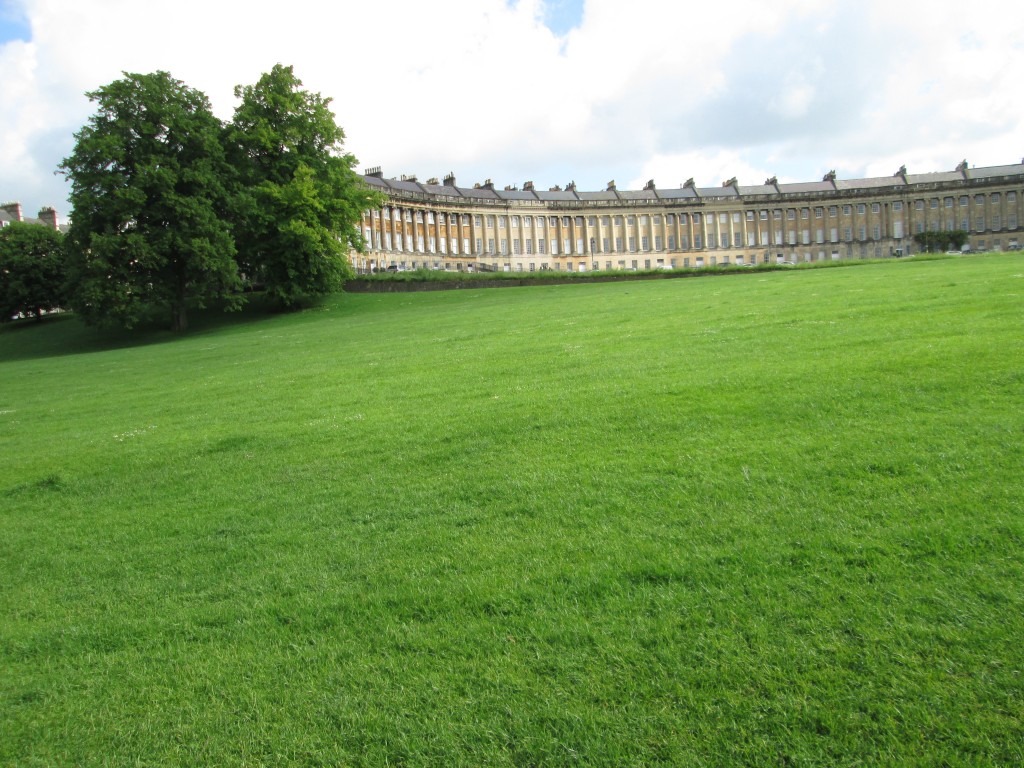Jane Austen’s family spent time and rented rooms and floors of rooms from time to time in Bath, Somerset, England. The refurbished Roman baths provided entertainment and promised healing any and all ills. The baths are fed by Britain’s only natural hot springs, but the Romans’ complex of springs, therapy rooms, and baths had been abandoned and buried once the empire fell in 480 AD. Just before the Austen family arrived in 1801, the King’s Bath had just been rediscovered, excavations having started in 1878. Perhaps this was why Jane’s father the Reverend George Austen had decided to retire and move his family there. The original Roman baths had been available to all Roman citizens, rich and poor. Not so during the Austens’ time.
The Royal Crescent and other stone “terraces” (apartment complexes such as in the photo below) provided high-status accommodations. Families could promenade in the nearby parks and along walks and pathways. But this quiet market and spa town was also known as dirty and unsanitary, suffering waves of bubonic and pneumonic plagues and cholera.

Down the hill in the Avon Valley, inhabitants suffered the acrid smells and pollution of the city’s numerous factories and woolen mills, where tradesmen and workers lived, and where no promenading was going on. The restorative Roman baths didn’t seem to help the poor. Food shortages and famine also affected rates of mortality.
That said, she set two of her six major novels in Bath: Northanger Abbey and Persuasion, both of which were published after her death. Bath is actually somehow referenced in all of her novels, which were all published anonymously, title pages simply stating “By a Lady.” Sense and Sensibility was her first published work in three volumes in 1811, when Jane was 35. Austen’s multiple early works written from age 11 to 17, are named “the Juvenilia” as a group (available on Amazon for $26.99).
Jane Austen (1775–1817) lived partly during the Georgian period, meaning during the reign of one of the King Georges, House of Hanover, and partly during the Regency Period. George I, George II, George III (of American Revolutionary War fame) and George IV, reigned in continuous succession for 114 years, 1714 to 1830. When George III was deemed unfit* for office, from 1811 until his death in 1820, his son and heir the Prince of Wales ruled England from 1811 as Regent. Once George III died in 1820, that prince became George IV and ruled England until his own death in 1830. Thus, the last six years of Austen’s life were during the Regency.
A Georgian house was square or rectangular (such as at left), made of brick, and featured symmetrical windows, shutters, and columns, plus arches, pediments, and columns. The Jane Austen Centre, located on Gay Street, the same street where she last lived in Bath, is in a Georgian building.
The Centre offers a glimpse of how that would have looked in her day. In the Centre’s Regency Tea Room, you can purchase all manner of souvenirs, including a “Jane Austen Blend” of tea. A particular favorite souvenir I look for is tea towels: lightweight, functional, and hanging artwork for the kitchen. I also may have sampled every scone, cream puff, turnover, sandwich, and little cake on offer during my visit and later walked off the calories (as if!) in front of the terraces, viewing the ash, beech, alder, and plane trees along the manicured lawns. I really appreciated all the benches.
Jane’s parents, George Austen and Cassandra Leigh, married in 1864, and the babies started coming: James, George, Edward, Henry, then Cassandra, Francis, Jane in 1775, and Charles. George, nine years older than Jane, never learned to speak and perhaps suffered from epilepsy. He was “boarded out” with Francis Cullum’s family for the rest of his life in Monk Sherborne, another Hampshire village nine miles from the Austens in Steventon. George never lived with his own family again and received few visits from his parents or siblings.
Jane’s brother Edward joined the military, worked in banking, and was the sibling perhaps most influential in allowing Jane to publish her work. He opened his home to her during her trips to London where she gained insight into the society life she would otherwise never have seen or experienced. Jane would have witnessed the growth of the factory system and how a third of England lived on the verge of starvation. Luddite protestors attacked new industrial machinery, and there were food riots across the countryside.
When her father George died in 1805, Jane’s family suddenly couldn’t afford to live in hilltop accommodations. Her father also had no money to pass on as dowries to his daughters Jane and Cassandra. The plots of Jane’s novels often describe how women depend upon marriage to gain social standing and economic security. Mrs. Austen and her daughters left Bath for good in 1806.
The 2013 movie Austenland conjures up a fantasy of an obsessed fan journeying to a Jane Austen theme park. The romantic comedy was produced by Stephanie Meyer, author of the Twilight books, and stars Keri Russel. I must confess, seeing the tea and pastries in the Regency Tea Room was pure joy, even with and in spite of the fanciful Colin-Firthy representation of Mr. Darcy on the wall. The 2007 film Becoming Jane stars Anne Hathaway, but true Jane Austen fans (“Janeites”) seem to prefer the 2007 television drama Miss Austen Regrets starring Olivia Williams.
Details of Jane’s life are sparse, partly because her older sister Cassandra burned most of her correspondence. Perhaps it was the family’s way of controlling Jane’s legacy, so that “younger nieces [she had over 30 nieces and nephews] did not read any of Jane Austen’s sometimes acid or forthright comments on neighbors or family members.” Only 161 letters survive out of over 3,000 she wrote. Though Jane had several suitors, she never married. In those times, women’s fortunes passed from male to male: father to husband, husband to son. Marriage was a complex economic decision, and men often decided on wives who could help fund land and a desired lifestyle.
Austen’s novels became prescribed reading for wounded and shell-shocked soldiers of World War I as part of their rehabilitation. According to blogger Danie Burton, “Jane Austen had come to represent Englishness that soldiers were fighting for and helped give a nostalgic view that England had remained unchanged from the past . . . .” Describing depression and fear during our current Covid-19 pandemic, Heloise Wood writes, “Beyond their preoccupation with love and romance, there is a layer of steel and a celebration of resilience in [Austen’s] books that may well inspire us as we read them in these deeply uncertain and circumscribed times.”
Jane Austen last lived with her brother Henry and sister Cassandra in Chawton Cottage, dying at a house in Winchester, likely from Addison’s disease (an adrenal insufficiency) or perhaps lupus. She was 41. She was buried inside Winchester Cathedral. Cassandra Austen also never married, dying at 72.
Jane’s life and times are kept alive with the 10-day Jane Austen Festival which includes the Regency Costumed Promenade, dance workshops, walking tours, high teas, talks, and a ball. Events in 2022 were cut back to honor Queen Elizabeth’s death.
* See Nigel Hawthorne bring George III alive in the 1994 movie The Madness of King George.

Post a Comment